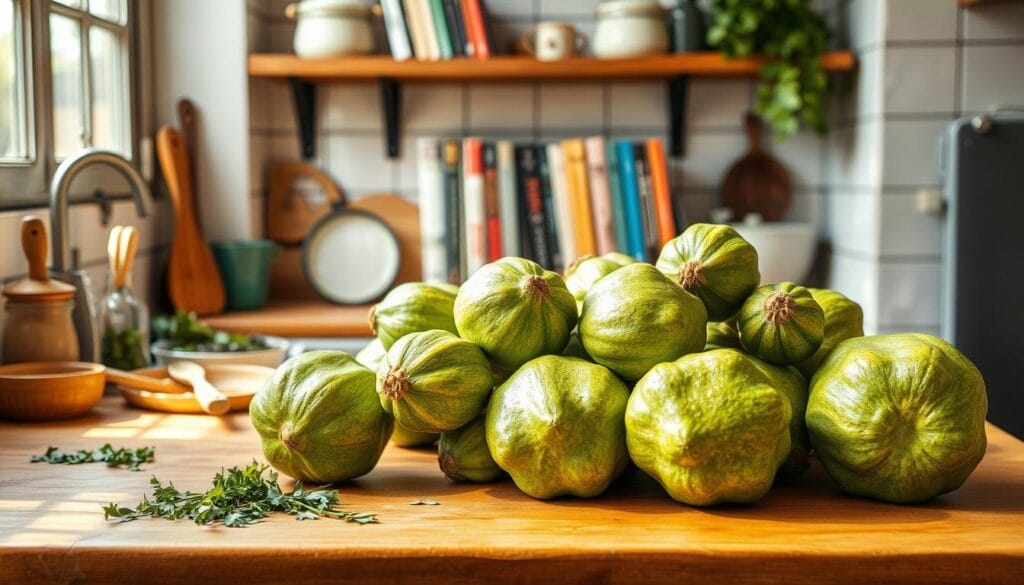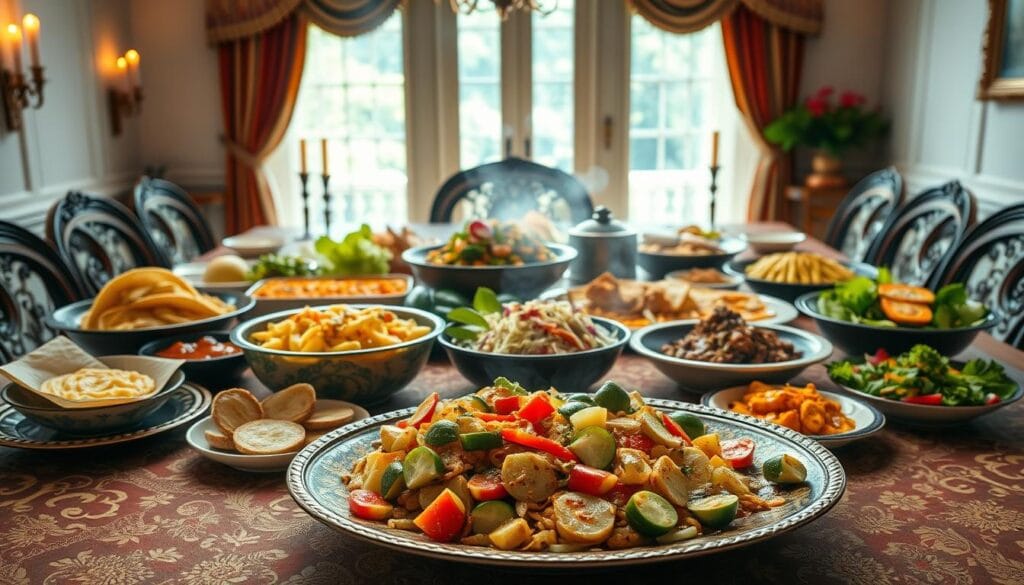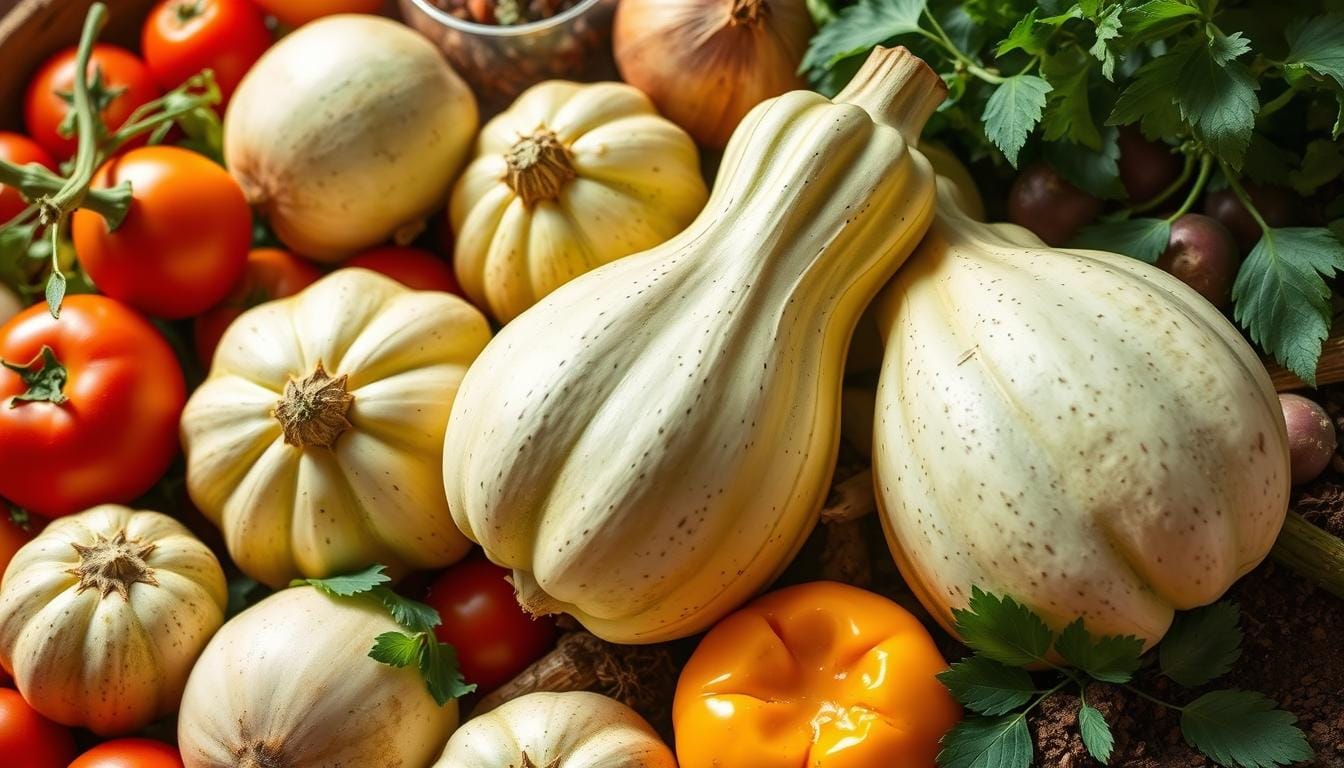Imagine finding a vegetable that changes your cooking world. Chayote recipes squash is that amazing find. It’s from Mexico and has a unique shape and taste.
It adds a crisp texture and a mild flavor to any dish. This makes any recipe special. Whether you’re an experienced cook or just starting, chayote squash has something for everyone.
Its texture is like a cucumber, and it’s as versatile as zucchini. You can use it in salads, stir-fries, and more. These recipes will take you on a culinary journey.
Chayote is not just tasty; it’s also healthy. It has only 39 calories per serving and is full of nutrients. It fits well in many cuisines. Let’s explore the delicious side of chayote together.
Introduction to Chayote: The Mexican Pear Squash
Explore the world of chayote, a unique squash that adds vibrant nutrition and flavor to your kitchen. It comes from Mexico and has won the hearts of many with its health benefits and cooking potential.
Chayote nutrition is packed with benefits, making it a great choice for healthy diets. This light green vegetable is full of essential nutrients but very low in calories.
Origins and Cultural Significance
Chayote comes from Mexico and is deeply rooted in Central American cuisine. For centuries, indigenous cultures have grown this squash for its versatility and nutritional value. Each region has its own way of preparing and enjoying it.
Understanding Chayote’s Unique Properties
- Mild, slightly sweet flavor
- Crisp texture similar to cucumber
- Extremely versatile in cooking methods
- Edible from skin to seed
Nutritional Profile and Health Benefits
Chayote’s health benefits are impressive. A single squash is a nutritional powerhouse with minimal calories. Here’s a look at its nutritional profile:
- Only 39 calories per squash
- 4 grams of dietary fiber
- 17% Daily Value of Vitamin C
- 47% Daily Value of Folate
- High in antioxidants
Research shows chayote may help with heart health, improve insulin sensitivity, and slow aging. Its high fiber content aids digestion and may help with weight management.
Whether you’re into nutrition or just want to try new foods, chayote is a great choice. Its versatility and nutrient-rich profile make it a must-try for health-conscious food lovers.
Essential Guide to Selecting and Storing Chayote
Choosing the right chayote squash is key for tasty dishes. Your shopping choices greatly affect your cooking’s quality.
Here’s what to look for in a chayote:
- Firm, smooth exterior without blemishes
- Light to medium green color
- Small to medium size for optimal flavor
- No soft spots or wrinkled skin
Chayote is in season from June to September. It’s a great summer squash for many recipes. Smaller squashes are tender and taste better.
Keeping chayote fresh is important:
- Room temperature storage: 2-3 days maximum
- Refrigeration: Up to one week
- Long-term preservation: Freezing or pickling
Tip for chayote dishes: Pick squashes with a light green color. They’re ripe and taste the best.
| Storage Method | Duration | Best For |
|---|---|---|
| Room Temperature | 2-3 days | Short-term use |
| Refrigeration | 5-7 days | Weekly meal planning |
| Freezing | 3-4 months | Long-term storage |
Follow these tips to keep your chayote fresh. This way, it’s always ready for your next cooking adventure.
Basic Preparation Techniques for Chayote Recipes
Preparing chayote squash recipes needs specific techniques for the best taste. Chayote is a versatile veggie that needs careful handling. Knowing the right ways to prepare it will turn it into tasty dishes.
Before starting your favorite chayote recipes, learning the basics is key. The prep process includes several important steps. These steps will make cooking fun and easy.
Cleaning and Handling Your Chayote
When picking chayote, choose firm, bright green ones without spots. To clean your chayote:
- Rinse well under cool water
- Scrub gently with a veg brush to get rid of dirt
- Pat dry with a clean towel
Cutting and Slicing Techniques
Proper cutting is key for great chayote squash recipes. Here’s how to do it:
- Use a sharp kitchen knife to avoid slipping
- Cut the chayote in half lengthwise
- Take out the central seed with a spoon
- Slice or dice as your recipe needs
Pre-Cooking Preparations
For most chayote recipes, a few extra steps can improve your dish:
- Some like to peel the skin, but it’s safe to eat
- Rinse your hands after handling to get rid of stickiness
- Blanching can make it softer in some dishes
With these prep techniques, you’re set to try many tasty chayote recipes. This squash is truly versatile.
Classic Chayote Recipes for Beginners

Exploring chayote recipes is a fun journey for home cooks. This versatile squash has a delicate flavor that works well with many cooking methods. It’s perfect for beginners or anyone wanting to try new vegetables.
Here are some easy and tasty chayote recipes to start with:
- Quick Sautéed Chayote
- Fresh Chayote Salad
- Roasted Chayote Squares
- Chayote Stir-Fry
A simple sauté is a great way to begin with chayote. Its mild taste makes it easy to add flavors. Here’s how to make a delicious chayote salad:
- Wash and peel the chayote
- Slice into thin, uniform pieces
- Sauté in olive oil for 3-5 minutes
- Season with salt, pepper, and herbs
Chayote is also great for those watching their diet. A typical chayote salad has:
| Nutritional Value | Per Serving |
|---|---|
| Calories | 45 kcal |
| Carbohydrates | 5g |
| Protein | 2g |
| Fat | 1g |
Try different chayote recipes to find your favorite. Pro tip: Choose firm, unblemished chayotes for the best taste and texture.
Creamy Chayote Soup Variations
Discover the magic of chayote soup, a delightful culinary experience. It turns this humble squash into a creamy, comforting dish. Chayote recipes offer a versatile approach to creating delicious and nutritious meals that will warm your soul.
Mexican kitchens have long celebrated the unique potential of chayote soup. They craft recipes that highlight its delicate flavor and smooth texture. This versatile ingredient becomes the star of numerous chayote recipes, specially in creamy soup variations.
Mexican-Style Crema de Chayote
The classic Mexican-style chayote soup brings together simple ingredients. It creates a luxurious dining experience. Key components include:
- Fresh chayote squash
- Rich cream
- Aromatic herbs
- Subtle spices
Vegetarian Soup Options
For those seeking plant-based alternatives, chayote soup offers endless possibilities. You can create a hearty vegetarian version by incorporating:
- Vegetable broth
- Roasted vegetables
- Plant-based cream alternatives
- Nutritional yeast for depth
Garnishing Ideas
Elevate your chayote soup with creative garnishes. They add texture and flavor. Consider topping your soup with:
- Toasted pumpkin seeds
- Fresh cilantro
- Crispy tortilla strips
- A drizzle of lime crema
Your chayote soup can be a canvas for culinary creativity. It transforms a simple ingredient into a restaurant-worthy dish. This will impress family and friends.
Sautéed Chayote Side Dishes
Discover the magic of chayote stir fry, a versatile and delicious side dish. It turns this humble squash into a culinary delight. Chayote vegetable dishes offer an incredible opportunity to explore unique flavors and textures in your kitchen.
When preparing chayote stir fry, focus on techniques that enhance its natural mild flavor. Use ingredients that complement its delicate taste. This creates a memorable dining experience.
Quick and Easy Sautéed Chayote Preparation
- Select fresh, firm chayote squash
- Peel and slice into thin strips
- Heat 2 tablespoons of oil in a skillet
- Sauté for approximately 3-4 minutes until tender
Nutritional benefits make chayote vegetable dishes an excellent choice for health-conscious cooks. A single serving provides:
| Nutrient | Amount |
|---|---|
| Calories | 59 |
| Carbohydrates | 7g |
| Protein | 2g |
| Fiber | 2g |
Flavor Enhancement Techniques
To elevate your chayote stir fry, consider these seasoning suggestions:
- Garlic and shallots for depth
- Fresh herbs like cilantro
- A splash of lime juice
- Pinch of cumin for warmth
Your chayote side dish can be stored in an airtight container for up to 3 days. Remember to reheat it to 165°F. Stir occasionally to maintain its delightful texture.
Creative Chayote Salad Combinations
Chayote salads are a refreshing and nutritious way to enjoy this versatile squash. Its crisp texture and mild flavor make it a great base for creative recipes. These recipes will make your meal prep exciting.
Exploring raw chayote preparations opens up a world of culinary creativity. Its firm texture is perfect for spiralizing. This creates unique salad experiences that excite your taste buds.
Raw Chayote Salad Inspirations
- Spiralized chayote with citrus vinaigrette
- Asian-inspired chayote slaw
- Mediterranean chayote salad with herbs
- Spicy Mexican-style chayote salad
Dressing and Seasoning Strategies
Elevate your chayote salad with these exciting dressing options. They complement its delicate flavor profile:
| Dressing Type | Flavor Profile | Recommended Pairing |
|---|---|---|
| Lime Cilantro Vinaigrette | Bright and Zesty | Mexican-inspired chayote recipes |
| Tahini Herb Dressing | Creamy and Earthy | Mediterranean chayote salad |
| Sesame Ginger Dressing | Tangy and Aromatic | Asian-style chayote slaw |
When preparing chayote salads, remember that seasoning is key. Fresh herbs, toasted nuts, and zesty spices can turn a simple salad into a masterpiece.
Nutritional highlights of your chayote salad include low calories (about 100 kcal per serving). It also has impressive health benefits. Each serving gives 3g of fiber, 8g of carbohydrates, and essential vitamins like vitamin C and B6.
International Chayote Cooking Styles

Chayote recipes take us on a journey around the world. This versatile squash fits into many cuisines easily. It’s loved in Latin America and beyond, making simple dishes special.
Every region has its own way of cooking chayote. Here are some international chayote recipe styles that show its versatility:
- Mexican Cuisine: Known for vibrant chayote curry preparations that blend traditional spices
- Cajun Cooking: Stuffed chayote dishes with rich, hearty fillings
- Creole Recipes: Savory chayote side dishes with complex flavor profiles
- South Indian Cuisine: Spiced chayote curries with aromatic masala blends
Cooking techniques for chayote recipes vary a lot. Some like it raw, while others slow-cook it for deep flavors. A chayote curry might use coconut milk in South India or smoky Cajun seasonings in Louisiana.
| Cuisine | Typical Chayote Preparation | Key Seasonings |
|---|---|---|
| Mexican | Sautéed or in soups | Cilantro, chili peppers |
| Cajun | Stuffed and baked | Creole seasoning, ham |
| South Indian | Coconut-based curry | Fennel, turmeric, coconut |
Exploring international chayote recipes opens up a world of creativity. Whether making a spicy curry or a delicate side dish, this squash offers endless possibilities for adventurous cooks.
Advanced Chayote Recipes for Experienced Cooks
Take your cooking to the next level with advanced chayote recipes. These recipes turn this versatile veggie into gourmet dishes. Home chefs can explore new cooking techniques and creative ways to prepare chayote.
Chayote dishes are a blank slate for culinary creativity. They push the limits of traditional cooking and introduce bold flavors. These recipes will wow even the pickiest eaters.
Elegant Stuffed Chayote Creations
Learn to make stuffed chayote recipes with these expert tips:
- Choose firm, smooth chayotes without blemishes
- Use precise cutting to hollow out the squash
- Try gourmet fillings like:
- Quinoa and herb mixture
- Goat cheese and roasted vegetable blend
- Spicy protein-packed Mediterranean-inspired stuffing
Gourmet Preparation Techniques
Make your chayote recipes stand out with these advanced methods:
- Braise chayote in white wine and herbs
- Grill with special marinades
- Make complex reduction sauces
- Use molecular gastronomy techniques
Pro tip: Roast chayote at 190 degrees Celsius. This temperature brings out rich, caramelized flavors in your dishes.
Pairing Chayote with Other Ingredients
Exploring chayote recipes opens up a world of culinary creativity. This versatile vegetable harmonizes beautifully with numerous ingredients. It’s a fantastic addition to many chayote vegetable dishes. Its mild, slightly sweet flavor blends well with various proteins and seasonings.
When preparing chayote recipes, consider these complementary ingredients:
- Proteins:
- Chicken
- Shrimp
- Pork
- White fish
- Fresh Herbs:
- Cilantro
- Parsley
- Thyme
- Cooking Fats:
- Olive oil
- Butter
Your chayote vegetable dishes can be elevated with strategic ingredient pairings. Pro tip: Sprinkle Parmesan cheese or crisp bacon as a finishing touch. This adds depth and texture to your chayote recipes. The vegetable’s subtle taste makes it incredibly adaptable to different cuisines and cooking styles.
Experiment with combinations like stir-fried chayote with shrimp, roasted chayote with herbs, or chayote salads featuring zesty dressings. Each preparation method reveals a new dimension of this remarkable squash.
Tips for Cooking Perfect Chayote Every Time
Mastering chayote recipes means understanding its delicate nature. Chayote squash recipes need precision and care for the perfect texture and flavor. Whether you’re new or experienced, these tips will improve your chayote dishes.
Professional chefs say to watch cooking times closely when making chayote recipes. It’s important to keep the vegetable crisp but tender enough to enjoy.
Common Cooking Mistakes to Avoid
- Overcooking: Chayote gets mushy fast, so cook it less
- Don’t skip steps like removing seeds and peeling
- Avoid using high heat all the time
- Don’t forget to season the chayote well
Expert Chef Recommendations
- Cook chayote for no more than 5-7 minutes when sautéing
- Use moderate heat to keep its texture delicate
- Add chayote towards the end of stir-fry recipes
- Try different seasoning techniques
When trying chayote squash recipes, remember it soaks up flavors fast. Quick cooking methods like light steaming or quick sautéing keep its crisp texture and nutrients.
Conclusion
Exploring chayote recipes opens up a world of flavors. This unique vegetable is not as well-known as zucchini or pumpkin. But, it’s packed with nutrients and is very versatile.
Chayote has many health benefits. It can help with weight loss and improve your metabolism. It’s low in calories, high in fiber, and full of nutrients.
One serving of chayote gives you a lot of folate and dietary fiber. This makes it a great choice for those who want healthy and tasty meals.
Adding chayote recipes to your meals can be exciting. It fits well with many cooking styles and cuisines. You can use it in salads, soups, or stir-fries. It adds a mild flavor and unique texture to your dishes.
Your journey with chayote is just starting. Try new recipes and enjoy the benefits it brings to your diet. It will make your meals more exciting and healthy.

